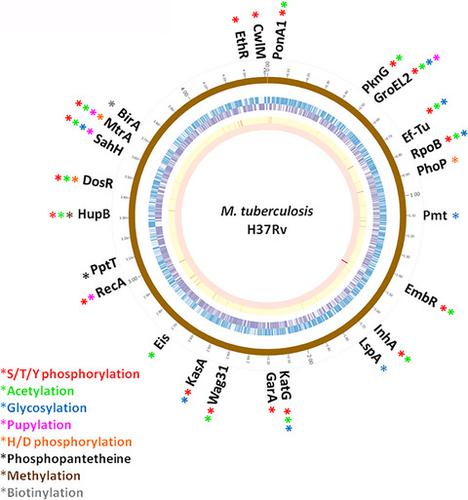Our official English website, www.x-mol.net, welcomes your feedback! (Note: you will need to create a separate account there.)
Role of post-translational modifications in the acquisition of drug resistance in Mycobacterium tuberculosis
The FEBS Journal ( IF 5.4 ) Pub Date : 2020-10-06 , DOI: 10.1111/febs.15582 Gunjan Arora 1 , Ankur Bothra 2 , Gareth Prosser 3 , Kriti Arora 4 , Andaleeb Sajid 1
The FEBS Journal ( IF 5.4 ) Pub Date : 2020-10-06 , DOI: 10.1111/febs.15582 Gunjan Arora 1 , Ankur Bothra 2 , Gareth Prosser 3 , Kriti Arora 4 , Andaleeb Sajid 1
Affiliation

|
Tuberculosis (TB) is one of the primary causes of deaths due to infectious diseases. The current TB regimen is long and complex, failing of which leads to relapse and/or the emergence of drug resistance. There is a critical need to understand the mechanisms of resistance development. With increasing drug pressure, Mycobacterium tuberculosis (Mtb) activates various pathways to counter drug-related toxicity. Signaling modules steer the evolution of Mtb to a variant that can survive, persist, adapt, and emerge as a form that is resistant to one or more drugs. Recent studies reveal that about 1/3rd of the annotated Mtb proteome is modified post-translationally, with a large number of these proteins being essential for mycobacterial survival. Post-translational modifications (PTMs) such as phosphorylation, acetylation, and pupylation play a salient role in mycobacterial virulence, pathogenesis, and metabolism. The role of many other PTMs is still emerging. Understanding the signaling pathways and PTMs may assist clinical strategies and drug development for Mtb. In this review, we explore the contribution of PTMs to mycobacterial physiology, describe the related cellular processes, and discuss how these processes are linked to drug resistance. A significant number of drug targets, InhA, RpoB, EmbR, and KatG, are modified at multiple residues via PTMs. A better understanding of drug-resistance regulons and associated PTMs will aid in developing effective drugs against TB.
中文翻译:

翻译后修饰在结核分枝杆菌耐药性获得中的作用
结核病 (TB) 是传染病导致死亡的主要原因之一。目前的结核病治疗方案漫长而复杂,失败会导致复发和/或出现耐药性。迫切需要了解耐药性发展的机制。随着药物压力的增加, 结核分枝杆菌( Mtb ) 会激活各种途径来对抗药物相关的毒性。信号模块引导Mtb进化 为一种可以存活、持久、适应并以对一种或多种药物具有抗性的形式出现的变体。最近的研究表明,大约 1/3 的注释 Mtb 蛋白质组经过翻译后修饰,其中大量蛋白质对分枝杆菌的生存至关重要。翻译后修饰 (PTM),例如磷酸化、乙酰化和瞳孔化,在分枝杆菌的毒力、发病机制和代谢中起着重要作用。许多其他 PTM 的作用仍在不断显现。了解信号通路和 PTM 可能有助于Mtb 的临床策略和药物开发 . 在这篇综述中,我们探讨了 PTM 对分枝杆菌生理学的贡献,描述了相关的细胞过程,并讨论了这些过程如何与耐药性相关联。大量药物靶点 InhA、RpoB、EmbR 和 KatG 通过 PTM 在多个残基上进行了修饰。更好地了解耐药性调节子和相关的 PTM 将有助于开发有效的抗结核药物。
更新日期:2020-10-06
中文翻译:

翻译后修饰在结核分枝杆菌耐药性获得中的作用
结核病 (TB) 是传染病导致死亡的主要原因之一。目前的结核病治疗方案漫长而复杂,失败会导致复发和/或出现耐药性。迫切需要了解耐药性发展的机制。随着药物压力的增加, 结核分枝杆菌( Mtb ) 会激活各种途径来对抗药物相关的毒性。信号模块引导Mtb进化 为一种可以存活、持久、适应并以对一种或多种药物具有抗性的形式出现的变体。最近的研究表明,大约 1/3 的注释 Mtb 蛋白质组经过翻译后修饰,其中大量蛋白质对分枝杆菌的生存至关重要。翻译后修饰 (PTM),例如磷酸化、乙酰化和瞳孔化,在分枝杆菌的毒力、发病机制和代谢中起着重要作用。许多其他 PTM 的作用仍在不断显现。了解信号通路和 PTM 可能有助于Mtb 的临床策略和药物开发 . 在这篇综述中,我们探讨了 PTM 对分枝杆菌生理学的贡献,描述了相关的细胞过程,并讨论了这些过程如何与耐药性相关联。大量药物靶点 InhA、RpoB、EmbR 和 KatG 通过 PTM 在多个残基上进行了修饰。更好地了解耐药性调节子和相关的 PTM 将有助于开发有效的抗结核药物。



























 京公网安备 11010802027423号
京公网安备 11010802027423号